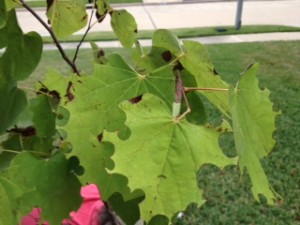
Hole Puncher?
The crazy holes in this redbud should probably be viewed as a more of a curiosity than a true problem in the Houston area. Damage like this is either caused by a Leaf Cutter Bee or a Leaf Cutter Ant. If the entire plant is being stripped…then you got a problem.
The Bee
These bees, like all bees, are only active during the day. They are solitary, non-aggressive and only the females cause damage to your plants. Leaf Cutter Bees cut these characteristic circles out of leaves and carry them back to their nest. They then use it to line the cigar-shaped tube they have created for their egg chamber. After each egg is deposited and sufficient rations packed in, it is sealed off with another leaf. Each egg has its own cozy bed. The females excavate a chamber in soft, rotting wood, that is easy for them to dig in. They are partial to the fascia https://www.contractorssolutions.com/fascia_soffits.htm#link on older homes or the joist https://en.wikipedia.org/wiki/Joist of older decks, arbors, pergolas, dead trees and large rose-bush canes. Keeping your home and exterior structures painted or sealed will extend their life and discourage these girls.You can read more about them at https://aggie-horticulture.tamu.edu/archives/parsons/misc/leafcutterbees.html Leaf Cutter Bee damage is a cosmetic issue, and rarely needs to be addressed. The bees are beneficial because, like all bees, they pollinate flowers, and pollinated flowers become food.
The Ants
These guys can be a problem for our outlying neighbors. Leaf Cutter Ants are not a common problem in Metro Houston, since they need space for their “town” and they prefer sandy soils as building material. Leaf Cutters are common from Louisiana, through east Texas, north of Houston then all the way through the northern parts of Mexico. A “town” can have multiple queens and 2 million residents. They can also be 20 feet deep, cover thousands of square feet and have a thousand entrances (no wonder it’s called a town). They forage at night, cutting the same circles that the bees do. These ants do not use the leaves for housing their young, but as a way of farming. While they cut the leaf, the ants are inoculating the cut piece with a fungus. They haul the leaves back to the mound where it is taken to climate controlled, underground “gardens” that they build. The inoculated leaf grows the fungus, which is the only source of food for all the ants in the nest. At this time, only Amdro ® Ant Block is labeled to deal with these guys. We also recommend that you spray your plants with a fungicide on a regular basis, to stop or slow down the growth of the fungus. If your plants won’t grow the fungus, maybe they’ll start shopping elsewhere. You can read more about Leaf Cutter Ants at https://citybugs.tamu.edu/factsheets/landscape/ants/ENT-1002/
